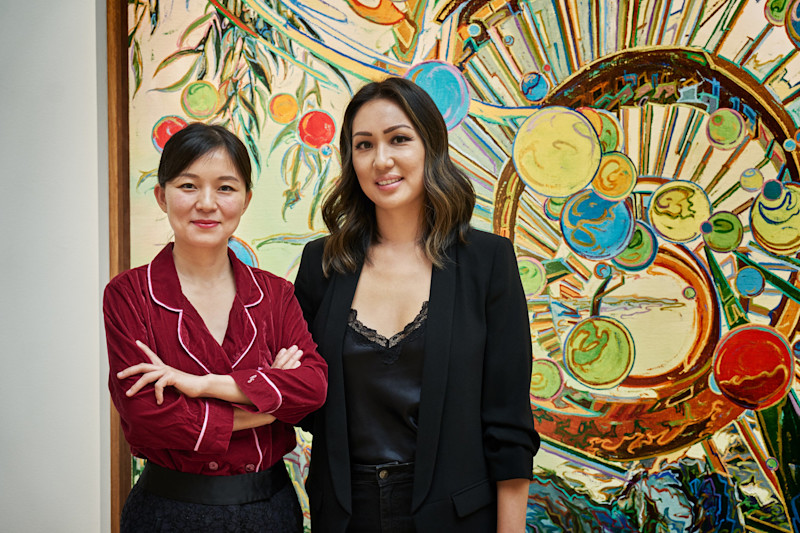Hanna Hansdotter 2.0, Blowing life into the Kingdom of Crystal
Interview
March 3, 2020

In early summer of 2018, the great palace hall at CFHILL was filled with 25 objects. Half a metre tall, they glistened and glimmered in pink, nacre, intense yellow, and greyish black, their contorted, bubbly, slanting and bulging bodies squirming, slithering. While Hanna Hansdotter calls them sculptures, they’re more akin to living alien organisms with one single function: to seduce and hypnotise. It was her first gallery show — and a febrile success. Now, the Skåne-born artist returns with a new, even wilder generation of glass bodies.
Looking back, what do you remember from that period a year and a half ago?
—The work with the sculptures took off from my graduate work from Konstfack University of Arts Crafts and Design. It was fun to have the opportunity to delve into the world of its ornamentation and sculptural work. I put a lot of time and money into the production for the last show, so much so that I had to borrow petrol money from a friend to be able to go to Stockholm for the opening of the show, ha ha. I’m really dependent on other people in my process, so I had to team up. In a way, knowing what I was supposed to do was nice; usually, I have to think about what to do next, but this became almost like a chore. But the repetitive work is something I also appreciate. It’s liberating. The thought process I’d done before, after all. I like the work horse role. But I was pretty exhausted afterwards, and a bit drained, spiritually.
Did this give you any insights?
—Yes, the feeling of having made something from nothing. That was a profound feeling for me. I was happy that my objects where so well received, it gave me fuel and opportunity to explore my method further.
Can you describe the new show?
—It’s 21 pieces in total; 15 are unique, and two come with two artist’s proofs each. The idea is to be freer in the foundry, for the sculptures to become more like abstract paintings. The process is based on repetition, but the result is never identical; it’s a method where, just like nature’s fractals, each repetition is different—giving birth to something that looks alive. The way in which they’re made is a bit different. The colour scheme is more intuitive, I want the pieces to be punk explosions of baroque colour. I work with common references such as the vase or vessel, and use the mirroring as a reflection of its own surrounding, the object intend to catch up the room and atmosphere. Mikael Jacobsson, the main glassblower I work with, was given freer rein. I love seeing what states of mind objects can invoke. These are a little more disturbing and intense than last time, I think.
What’s next after the new show at CFHILL?
—I’ve bought a farm. The plan is to get some animals and a summer studio. My dream is to have a donkey, a horse, two goats, and chickens. Not that I like chickens; I’m scared of birds — but I love eggs.
Looking outside of Sweden, you’ve gotten a lot of international attention recently by influential media outlets. How do you feel about becoming an international success?
—Im feeling pretty ready to scale up my work, and also to do more international collaborations and shows. I hope that will happen.
There are several people involved in the creative process whose knowledge and effort Hansdotter depends on: the mould maker, the glassblowers and the cold worker. The shape is determined by the hexagonal iron lattice, constructed using the corresponding ancient technique: welded bars and pipes are fashioned into grids, with patterns borrowed from historical architecture, both Christian ornaments and Islamic arabesques. Six walls form a hexagon out of which the glass paste will soon flow out of. One soft breath into the pipe and the body begins to grow. Here follow a few critical instants where the artist has a couple of minutes to manipulate the form, give it shape. Then: the cooling, cold working, and mirroring of the inside. An endeavour carefully planned, indeed, almost choreographed. Careless movements and a lost instant can undo it all, with an object lacking the desired qualities. Mould-blowing is about streamlining, and repetitive production.
Hanna Hansdotter’s story is tightly intertwined with another — that of Sweden at the dawn of industrialisation. A landscape rich in forests, and a group of people who, sometime in the 18th century, decided that the area was suitable for large-scale glassblowing. They didn’t know at the time how large it would get. The abundance of firewood was a precondition for the ovens that were to generate the tremendous heat required, and many glasswork foundries were built here. With a booming industry, competition followed, and the foundries began to specialise in different styles. Enter the artists.
When the competition for the thinnest, most decorated, most colourful, most delicately engraved glass was at its most intense, rumour of the country up north spread across the world, and ‘Swedish glass’ became a term of admiration. Today, only Kosta remains. And 10 years ago, it was to Kosta that Hanna Hansdotter arrived — a place where the glass industry had recently gone through a substantial paradigm shift. As the old era of the famous Swedish 'Kingdom of Crystal' was ending, Hanna Hansdotter stepped in—a new beginning.



